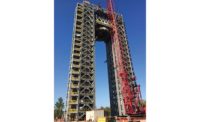One Thousand Museum Residences by Zaha Hadid Architects
Miami
Best Project
Owner 1000 Museum LLC
Lead Design Firm Zaha Hadid Architects
General Contractor Plaza Construction
Engineers DeSimone Consulting Engineers (structural) and HNGS Consulting Engineers (MEP)
Architect of Record O’Donnell Dannwolf & Partners Architects
Designed by the late Pritzker Prize-winning architect Zaha Hadid, the 62-story One Thousand Museum Residences project in Miami features a structural exoskeleton comprised of glass-fiber-reinforced concrete that simulates an undulating piece of sculpture. Not merely aesthetic, the tower’s exoskeleton is designed to carry the tower’s gravity loads. A traditional approach to withstanding wind pressure on a 709-ft-tall tower would have required significantly thicker shear walls, resulting in less sellable area for the developer.
As a solution, DeSimone Consulting Engineers used the tower’s sculptural features as a structural exoskeleton. The modified structural element acts as a bracing system that works with a traditional shear-wall system to achieve thinner shear walls. For the project’s bottom half, contractors used 12,000-psi concrete for the shear walls and exoskeleton columns. A 10,000-psi mix was used for the upper half.
Finding an economical and practical solution to form the unconventionally shaped exoskeleton was a primary challenge. Analysis showed that the use of traditional cast-in-place forming techniques with wood formwork would take too long and not produce consistent finish and color. As an alternative, DeSimone proposed using glass-fiber-reinforced concrete (GFRC) for left-in-place formwork. From its Dubai facility, GFRC contractor Arabian Profiles produced a three-month supply ahead of schedule. Overall, this approach reduced the project’s construction schedule by seven months, compared with the traditional forming method.
According to DeSimone, the project marked the first-ever use of GFRC as the permanent formwork of main structural elements in a high-rise building, thus serving as a real-world example of a potentially time-saving approach.









